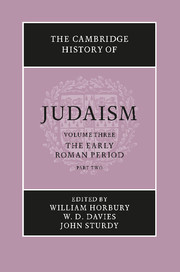Book contents
- Frontmatter
- 1 The archaeology of Palestine 63 bce–ce 70
- 2 The Herodian Temple
- 3 Recent archaeology in Palestine: achievements and future goals
- 4 The contribution of Jewish inscriptions to the study of Judaism
- 5 The social, economic and political history of Palestine 63 bce–ce 70
- 6 The Diaspora in the Roman period before ce 70
- 7 The Gentiles in Judaism 125 bce–ce 66
- 8 Gentiles as seen by Jews after ce 70
- 9 The synagogue
- 10 The Temple and the synagogue
- 11 The early liturgy of the synagogue
- 12 Women in the synagogue
- 13 The Pharisees
- 14 The Sadducees – their history and doctrines
- 15 The Essenes
- 16 The baptist sects
- 17 The troublemakers
- 18 The Samaritans and their sects
- 19 Galilean Judaism and Judaean Judaism
- 20 Jesus: from the Jewish point of view
- 21 Paul: from the Jewish point of view
- 22 Jewish Christianity
- 23 Apocalyptic: the disclosure of heavenly knowledge
- 24 The Qumran sectarian writings
- 25 The Dead Sea Scrolls and pre-Tannaitic Judaism
- 26 Prayer in the Qumran Texts
- 27 Philo of Alexandria
- 28 Josephus (ce 37–c. 100)
- 29 The rabbi in second-century Jewish society
- 30 The Hellenistic–Roman Diaspora ce 70–ce 235: the archaeological evidence
- 31 The legacy of Egypt in Judaism
- 32 Jewish elements in gnosticism and magic c.ce 70–c.ce 270
- Bibliographies
- Index
- References
23 - Apocalyptic: the disclosure of heavenly knowledge
Published online by Cambridge University Press: 28 March 2008
- Frontmatter
- 1 The archaeology of Palestine 63 bce–ce 70
- 2 The Herodian Temple
- 3 Recent archaeology in Palestine: achievements and future goals
- 4 The contribution of Jewish inscriptions to the study of Judaism
- 5 The social, economic and political history of Palestine 63 bce–ce 70
- 6 The Diaspora in the Roman period before ce 70
- 7 The Gentiles in Judaism 125 bce–ce 66
- 8 Gentiles as seen by Jews after ce 70
- 9 The synagogue
- 10 The Temple and the synagogue
- 11 The early liturgy of the synagogue
- 12 Women in the synagogue
- 13 The Pharisees
- 14 The Sadducees – their history and doctrines
- 15 The Essenes
- 16 The baptist sects
- 17 The troublemakers
- 18 The Samaritans and their sects
- 19 Galilean Judaism and Judaean Judaism
- 20 Jesus: from the Jewish point of view
- 21 Paul: from the Jewish point of view
- 22 Jewish Christianity
- 23 Apocalyptic: the disclosure of heavenly knowledge
- 24 The Qumran sectarian writings
- 25 The Dead Sea Scrolls and pre-Tannaitic Judaism
- 26 Prayer in the Qumran Texts
- 27 Philo of Alexandria
- 28 Josephus (ce 37–c. 100)
- 29 The rabbi in second-century Jewish society
- 30 The Hellenistic–Roman Diaspora ce 70–ce 235: the archaeological evidence
- 31 The legacy of Egypt in Judaism
- 32 Jewish elements in gnosticism and magic c.ce 70–c.ce 270
- Bibliographies
- Index
- References
Summary
DEFINING APOCALYPTIC
Much of the material in the Apocrypha and Pseudepigrapha dealt with in chapter 12 in volume ii is concerned with what is referred to as apocalyptic. This is an aspect of Judaism over which there has been much dispute as to its interpretation and significance, and it is appropriate at this point in the history to attempt to assess it. This is not because, as has sometimes been erroneously asserted, apocalyptic became a spent force after the Roman period: it continued, and broke out with volcanic intensity in the Sabbatianism of the seventeenth century and is still alive. An assessment is necessary here for another reason. The increasingly dominant Rabbinic form of Judaism, which gained ascendancy after the collapse of the revolts against Rome in the first century, overshadowed apocalyptic, sometimes aggressively rejected it and often came to regard concentration upon it as a menace. Perhaps particularly under the vast influence of the great work of G. F. Moore, who had reacted against what he considered an over-concentration on apocalyptic to the neglect of Rabbinic sources, the view became common that, like Seventh Day Adventism, for example, within contemporary Christianity, apocalyptic belonged to the fringes of Judaism. As a result it was urged that apocalyptic materials should not be taken as representative of essential Judaism: this distinction was reserved for more strictly Rabbinic sources.
This view was contested by W. D. Davies and others who rejected any sharp distinction between Pharisaic or Rabbinic Judaism and apocalyptic. And in recent years there has been renewed interest in apocalyptic and in its place in Jewish and Christian theology.
- Type
- Chapter
- Information
- The Cambridge History of Judaism , pp. 776 - 797Publisher: Cambridge University PressPrint publication year: 1999

